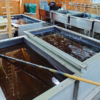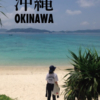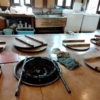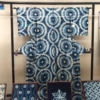vol.32 Awa-Shijira | 阿波しじら織
2022年夏、四国・徳島へ行ってきました。目的は、阿波藍と阿波しじら織の見学。
ネットで見つけた長尾織布さん、メールでやりとりしながら広幅の生地を購入し、見学する旨をお伝えしていました。そして歩いて見学にいけるように、近くの鱗楼というお遍路向けの宿を予約。
当日は長尾織布の長尾さんが直接お話をしてくださり、イージーパンツを作りたいということ、クラウドファンディングに掲載することを伝えると、快く対応していただいけて一安心。伝統を守りつつも、新しい試みや若い人たちの動きを柔軟に受け入れているようでした。
長尾織布さんは見学は随時受け付けているようで、工場をぐるっと1周しながら担当の方に説明していただきました。ガシャガシャ動く機織り機、染織工場独自のギザギザの鋸屋根、藍染の樽、糸を揃える機械、シボを作る機械と工程ごとに専用の機械と技術がありました。
In the summer of 2022, I visited Tokushima, Shikoku. The purpose of the visit was to see Awa Indigo and Awa Shijira textiles.
I found Nagao Orifu on the Internet, purchased a broadcloth while exchanging e-mails, and told them I would visit. I then made reservations at a nearby inn for pilgrims called Urokorou so that I could visit on foot.
Mr. Nagao of Nagao Orifu spoke directly and when I told him that I wanted to make easy pants and that I would post the information on our crowdfunding page, he was very happy to help us out. While preserving tradition, the company seemed to be flexible and open to new challenges and the movement of young people.
Nagao Orifu accepts tours at any time, and the person in charge gave us an explanation as we circled around the factory. There was a weaving loom that rattles, a jagged saw-roof unique to the weaving factory, an indigo-dyeing barrel, a machine for aligning threads, and a machine for creating a crinkle, as well as specialized machines and techniques for each process.
伝統を紡ぐ、長尾織布 Spinning Tradition, Nagao Orifu

▲織物・染色工場の特徴である鋸屋根。光を均等に取り入れることができます。太い柱や梁で作られた木造建築です。
Sawed roofs are a feature of textile and dyeing factories. It allows light to enter the building evenly. The wooden structure is built with thick pillars and beams.

▲機場(はたば):小巾織機・広巾織機・と揃い、着物・洋服に適した反物が織られます。
Hataba (loom): The small width loom, wide width loom, and other looms are available to weave fabrics suitable for kimonos and western-style clothes.

▲染色場:糸を化学染料で染めた後、水洗いや糊付けをします。藍染場もあります。
Dyeing area: Yarn is dyed with chemical dyes, then washed and glued. There is also an indigo dyeing area.

▲糸繰り:綛という糸の束を木管に撒きなおします。糸の太さはさまざまで、しぼが生まれる30番の綿糸を主に使っています。
The reeling: A bundle of threads called a skein is re-spun into a wooden pipe. The thickness of the threads varies, and the most common type used is No. 30 cotton thread, which produces a shibori.
2023年に阿波しじら織を使ってのミャンマーパンツを作る予定です!
阿波しじら織・藍染 長尾織布合名会社 Nagao Orifu LLC
https://awa-shijira.com/






